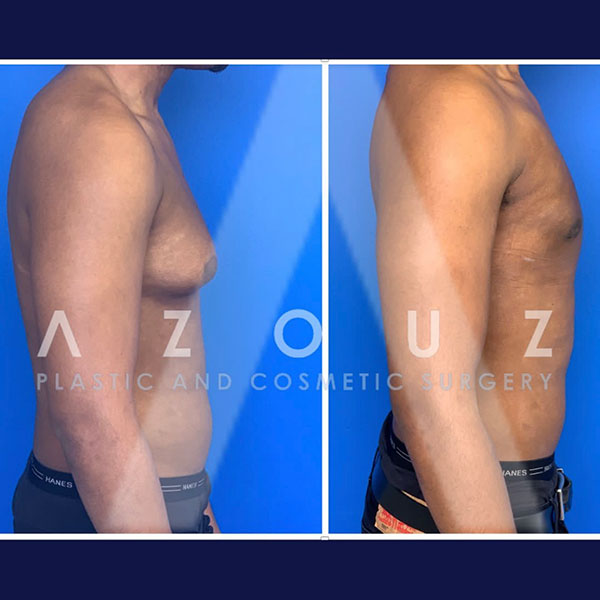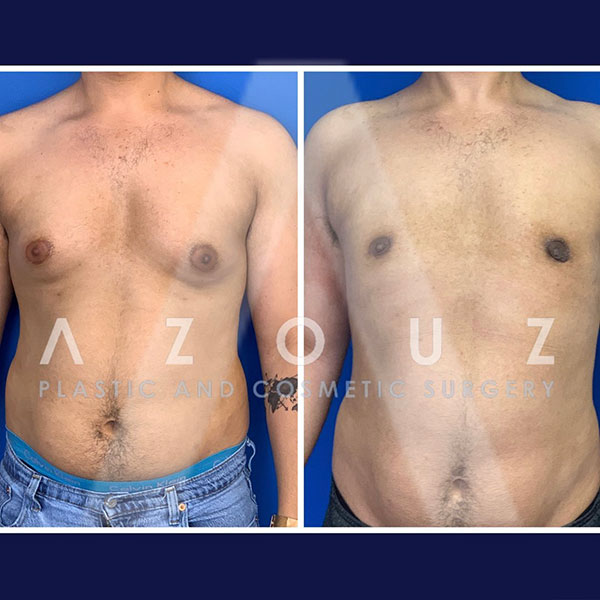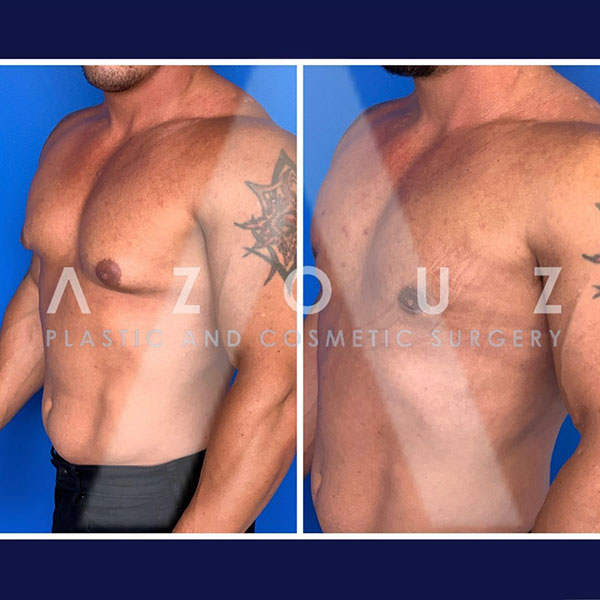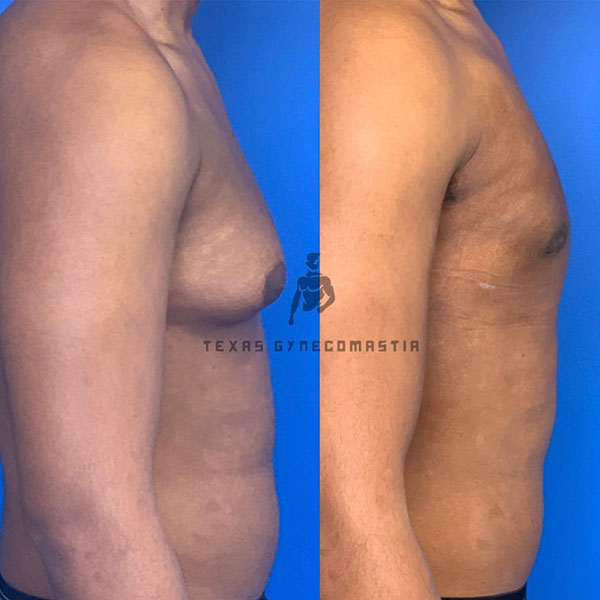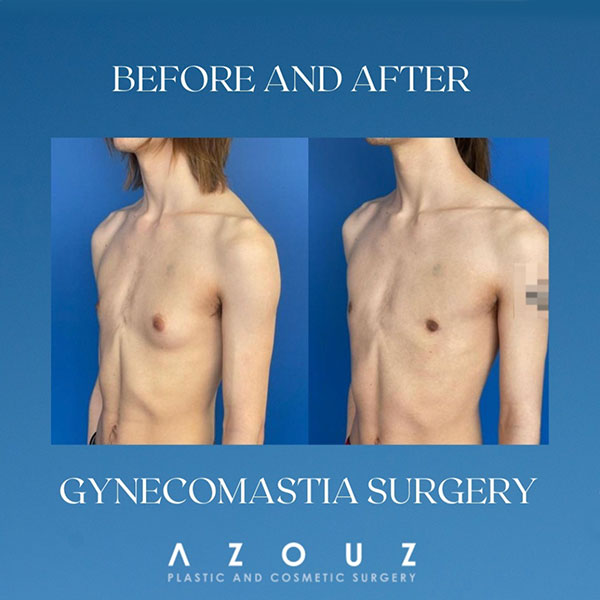Gynecomastia Surgery in Dallas – Male Breast Reduction
Male Breast Reduction also known as Gynecomastia surgery is a surgical treatment used to reduce the size of male breasts enlarged because of excess glandular tissue. This condition is called gynecomastia or “gyno” and is very common—but, it can become concerning, causing many men to feel self-conscious about the appearance of their chest. Gynecomastia surgery with top-rated plastic surgeons Dr. Solomon Azouz and Dr. David Azouz at their Dallas, Texas office can help the patient reduce the amount of breast tissue and provide a more masculine and cosmetic appearance.
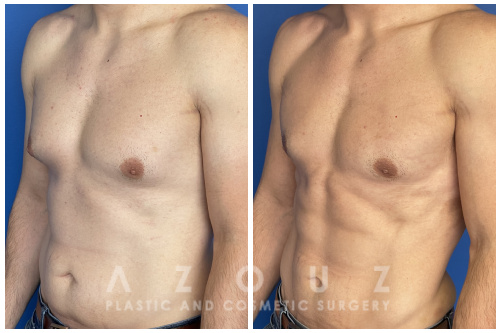
This thirty two year old man was bothered by stage 2 gynecomastia. He was also interested in removing stubborn fat from his abdomen. He underwent a Daddy Do-Over with glandular removal of his male breasts and liposuction of his chest and abdomen. He was extremely happy with the scarless results and quick recovery.
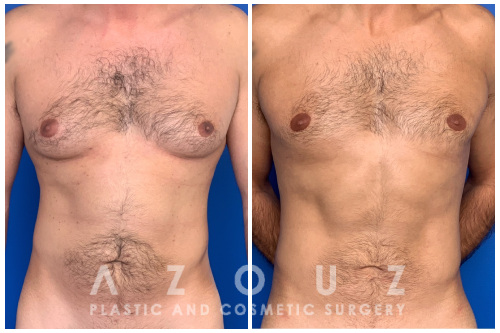
This young man complained of gynecomastia since he was a teenager and was conscious of wearing tight shirts. He underwent minimally invasive male breast reduction with liposuction and gland removal. His results demonstrate a flatter chest and scarless results.

This man was bothered by his chest asymmetry, as his left breast was larger than his right breast. He underwent gynecomastia surgery to remove the male breast tissue and liposuction of stubborn chest fat. Dr. Azouz used specialized techniques to improve skin laxity and reduce the need for additional skin removal surgery. He felt much more confident after his surgery.
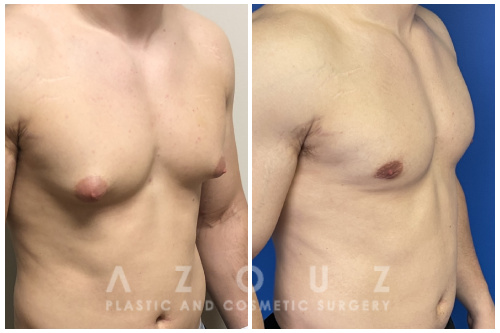
This young man reported that most men in his family had gynecomastia, as it is hereditary. He was bothered by his puffy nipples and complained of grade 3 gynecomastia. He had liposuction and removal of the glandular breast tissue to achieve a flat, more masculine chest. He was very happy with the results and felt more comfortable in tight-fitting shirts.

This young man complained of “man boobs” since he was a teenager that did not improve with diet or exercise. He chose to undergo minimally invasive gyno surgery to treat grade 1 gynecomastia and achieve a flat, more masculine chest.
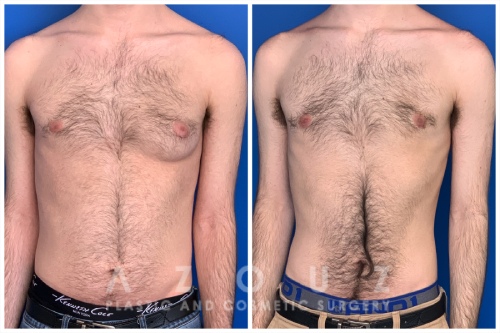
This man was bothered by chest asymmetry, as his left breast was larger than his right. He had mild grade 1 gynecomastia of his right breast and grade 2 gynecomastia of his left breast. He underwent liposuction and the removal of both male breasts to achieve a symmetrical, flat chest. He was thrilled with the results and felt more comfortable with a masculine chest.
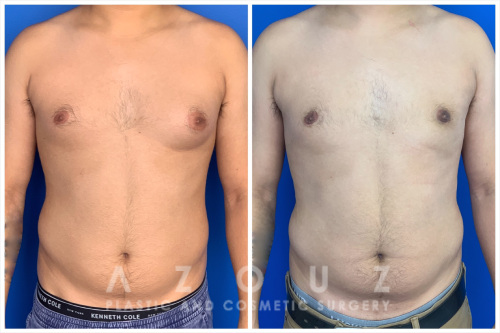
This man was bothered by his male breasts and chest asymmetry. He stated that his gyno did not go away with exercise. He desired liposuction and gland removal of both man boobs to achieve a flatter symmetrical chest. He was happy with a quick recovery and scarless results.
What is Gynecomastia?
Gynecomastia, commonly known as “man boobs,” is characterized by an abnormal growth of breast tissue in men. It may appear as a localized enlargement or swelling in the chest region and may cause discomfort and/or low self-esteem in men of various age groups. Gynecomastia can range in severity from a small increase in breast tissue to a more obvious and significant enlargement spreading throughout a large area of the chest. Often male gynecomastia can feel like “rocks” in the chest. Gynecomastia is nearly impossible to improve by diet and exercise and most often requires excision by a plastic surgeon.
Gynecomastia may affect males of all ages, from adolescents going through puberty to adults. It can appear
unilaterally (affecting only one breast) or bilaterally (affecting both breasts), and it can be caused by a number of reasons. Gynecomastia is frequently related to hormonal imbalances, particularly an increase in estrogen relative to testosterone levels; however, obesity or certain medications and substances can also contribute to its development.
Dr. Azouz finds that in his patients, the most common cause of developing gynecomastia at the time of puberty is a genetic etiology that does not resolve with time.
This means that hormonal medications often do not work to improve gynecomastia.
What are the stages of gynecomastia?
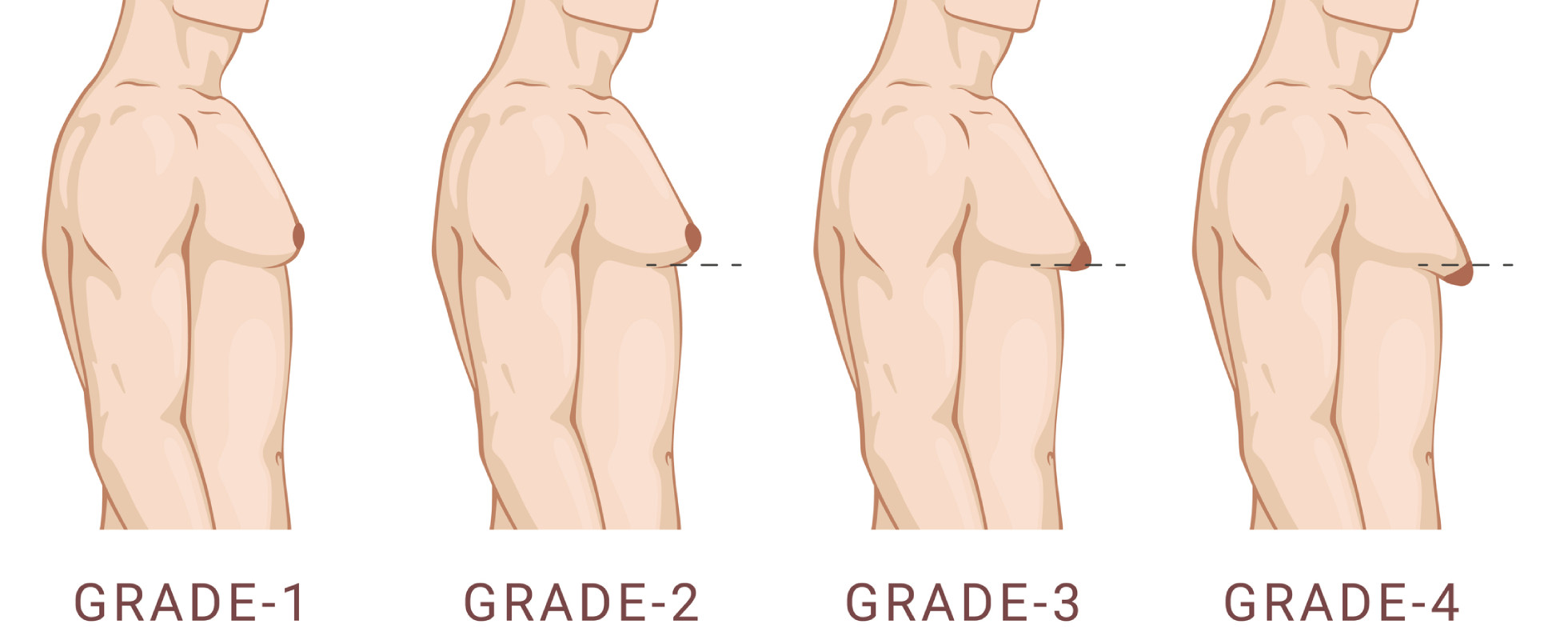
Gynecomastia is classified into four stages based on the severity and amount of growth of the breast tissue. These grades help both physicians and patients understand the course of the condition and determine the best treatment method. Grade I gynecomastia is defined as enlargement that is confined to a small, localized area, usually behind the areola. Grade II gynecomastia is characterized by moderate gynecomastia and more widespread breast tissue growth that goes beyond the areola. Grade III gynecomastia is defined as moderate-to-severe, with significant breast tissue protrusion. The most profound type, Grade IV, has a significant increase in breast tissue with sagging of the breast and may give the chest a more feminine aspect. Regardless of the grade of gynecomastia, surgery often offers the best treatment for gynecomastia for an ideal masculine chest. Dr. Azouz has included a fifth category of gynecomastia that involves a large amount of breast tissue to be removed, akin to a woman who requires a female breast reduction.
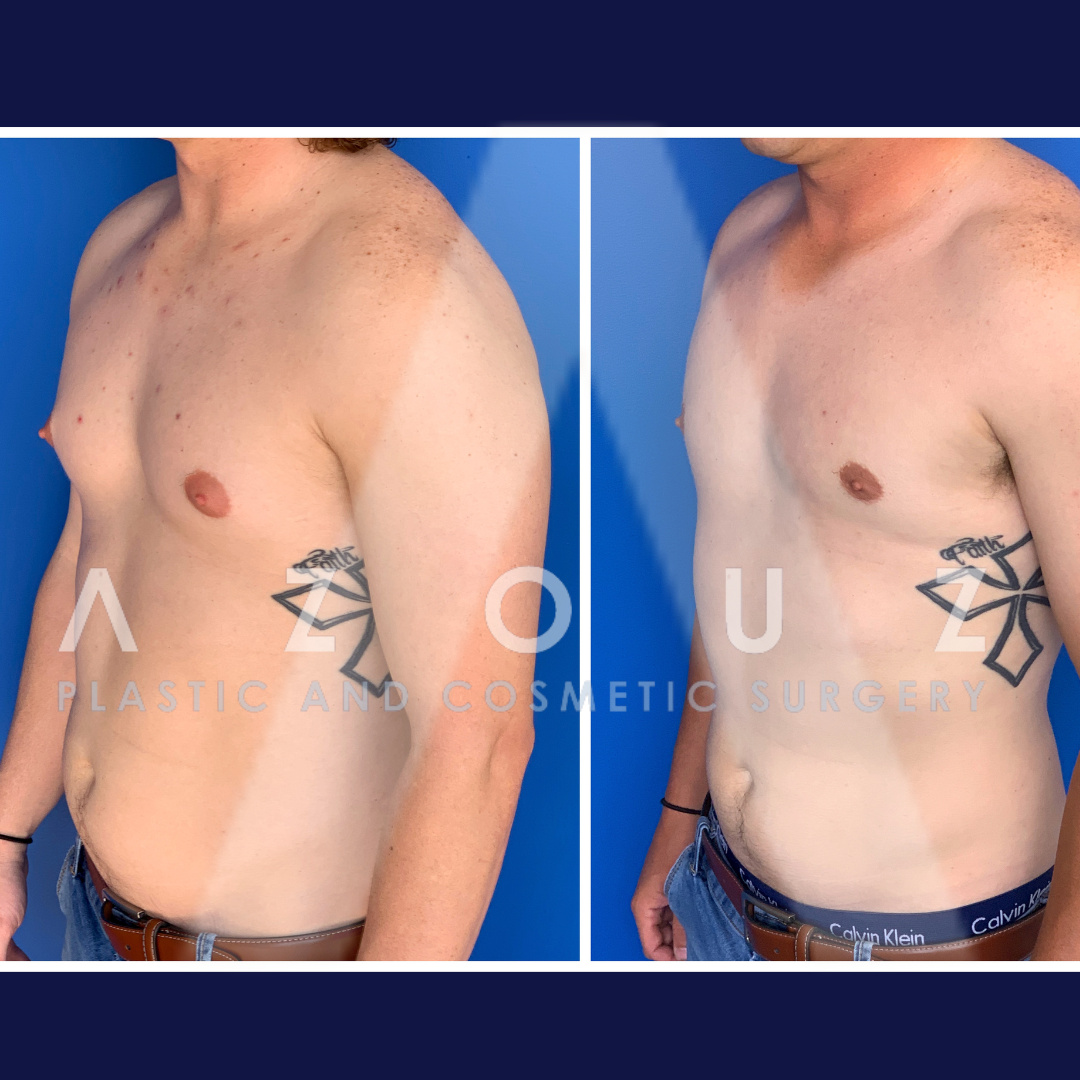
Grade 1
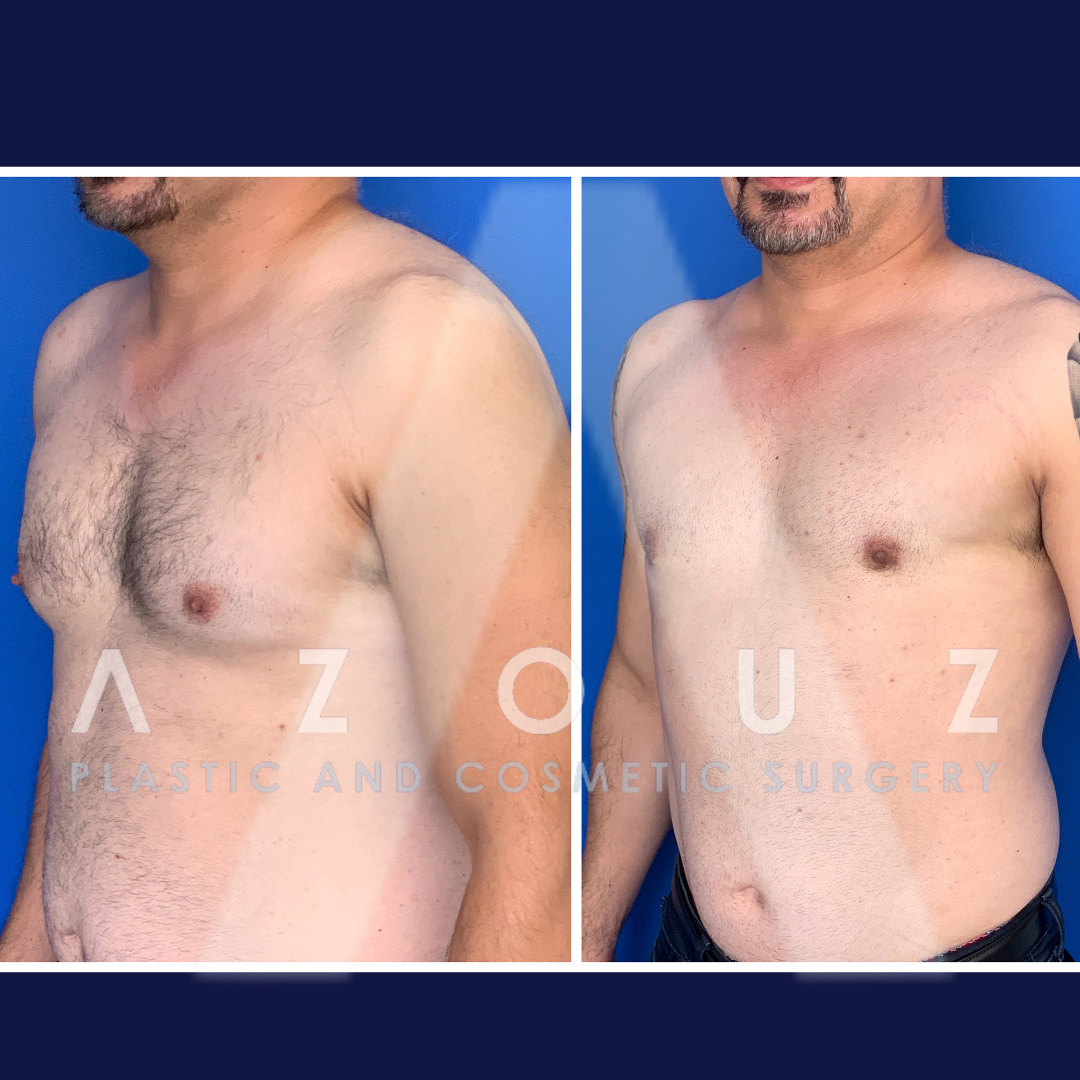
Grade 2
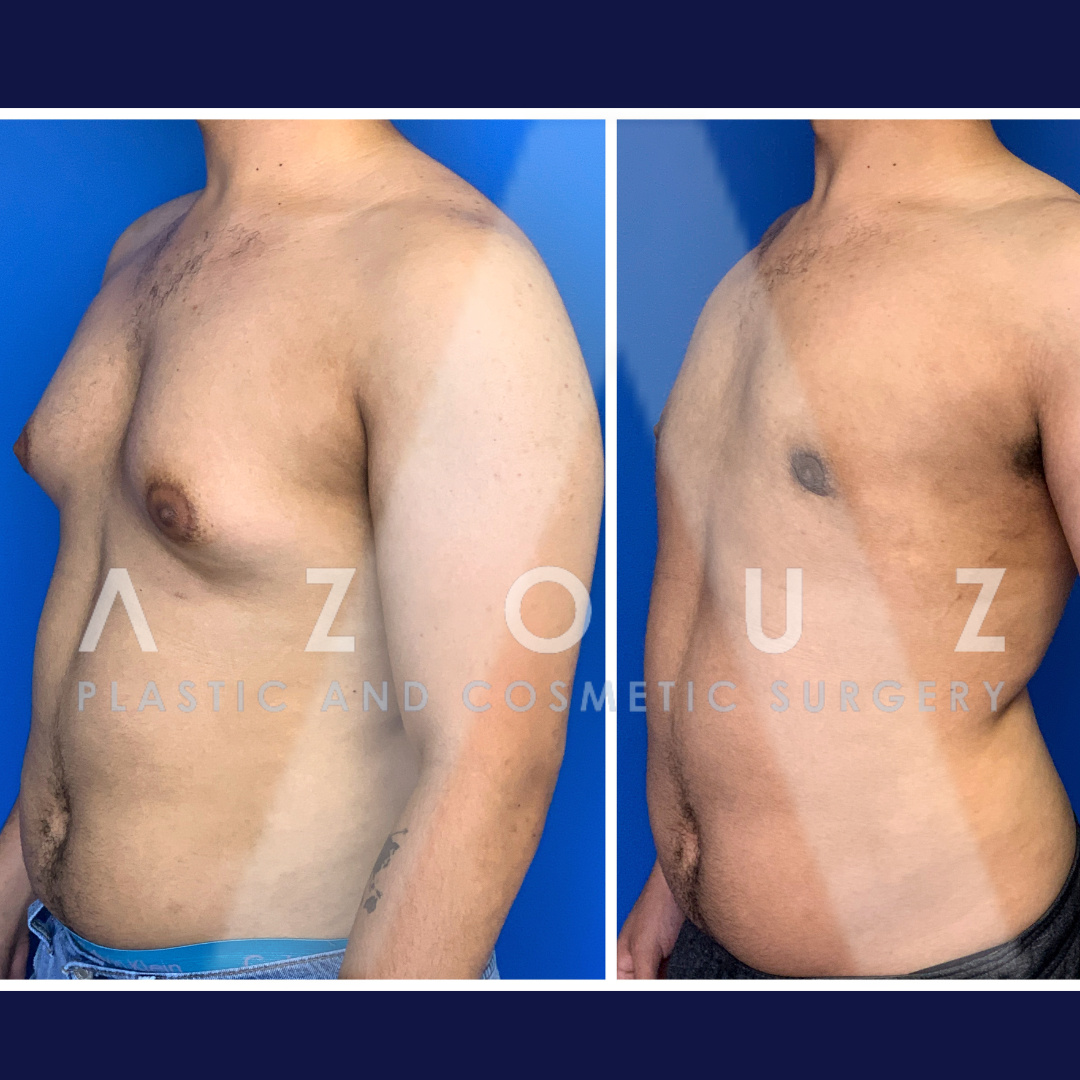
Grade 3
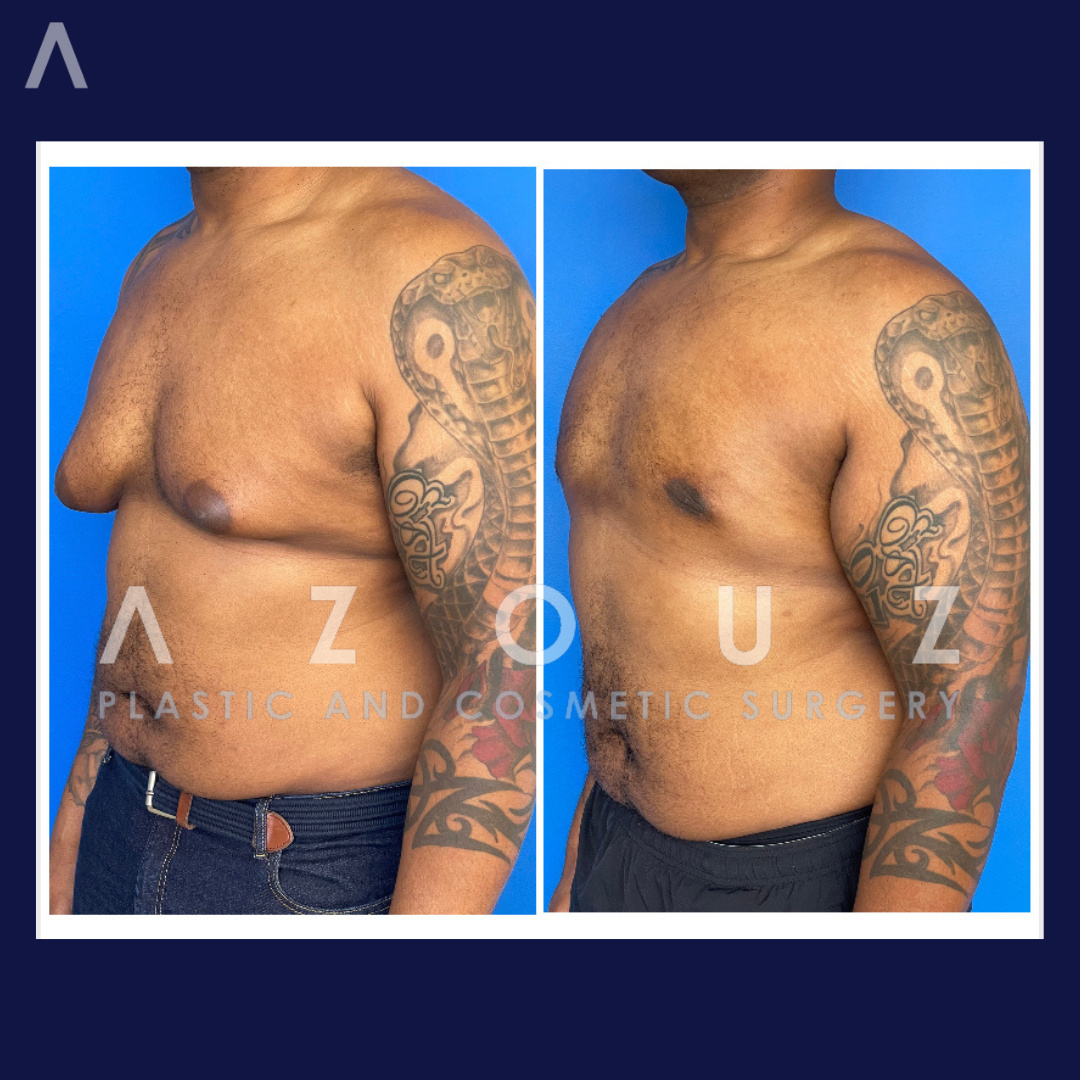
Grade 4
What is the difference between gynecomastia and pseudogynecomastia?
Despite having similar names, gynecomastia and pseudogynecomastia are two different conditions that affect the male chest area. The growth of firm breast tissue in men is known as gynecomastia. It is distinguished by a firm, rubbery, or palpable lump beneath the nipple-areola complex, which may result in a feminine-appearing chest and often extends beyond the nipple-areola complex. However, the buildup of excess chest fat rather than an increase in breast tissue is the cause of pseudogynecomastia. It is frequently associated with conditions such as obesity, genetics, or poor diet. The look of pseudogynecomastia is fatty and soft. Men will often have a mix between both gynecomastia and pseudogynecomastia.
Gynecomastia Articles
View Articles For Gynecomastia-
What causes gynecomastia to be painful?
Gynecomastia is painful because the hard tissue behind the nipple can swell and rub on the sensoryContinue reading
-
Pros and cons of Different Types of Liposuction
The goal of liposuction is to improve body contour and eliminate extra fat. With so many differentContinue reading
-
Celebrities with Gynecomastia
Gynecomastia is the development of enlarged breast tissue in men. It can be brought on by aContinue reading
What causes gyno in men?
There are a lot of factors that can contribute to man boobs; however, the exact cause is not known. The main triggers for this condition are puberty and, at other times, hormonal imbalances. Some external and medical factors that can also cause gynecomastia are:
- Weight gain, which can result in more estrogen production
- Medications for an unrelated condition
- Steroid use
- Hormone replacement therapy
- Despite these triggers, the cause of gynecomastia is almost always not the fault of the patient and is caused by a genetic inheritance
![]() Click here to see our Instagram profile
Click here to see our Instagram profile
Who is a candidate for gyno treatment?
While abnormal development of male breasts is typically not caused by a serious medical illness, it can be a side effect of some medical issues. Because of this, it is important to see a physician to discuss possible causes before having a consultation for gynecomastia treatment. If your gynecomastia or “gyno” is not caused by a medical condition or hormonal imbalance, you may be a good candidate for male breast reduction. Other factors that may indicate that you are a good candidate for the procedure are:
- The soft, fatty breast tissue in your breast area has not responded to a healthy lifestyle
- You would like to correct the asymmetry in your breasts
- You have maintained a healthy and stable weight
- The size of your breasts is causing you physical and/or social discomfort
- You no longer use steroids
What to Expect During Male Breast Reduction in Dallas
The extent and process of the procedure will vary depending on your desired changes and Dr. Azouz’s professional opinion on achieving your goals. Through precise and minimalistic incision(s), Dr. Azouz reduces the breast size by removing excess breast tissue and skin, flattening, and enhancing the chest contour. In many cases, the position and size of the areola may be altered to develop a more natural appearance.
The specific techniques used can differ based on the nature of the gynecomastia and the patient’s goals. Board-certified plastic surgeon Dr. Azouz usually combines liposuction with excision to remove both glandular tissue and extra fat, resulting in a more masculine chest.
With liposuction, small incisions are made close to the chest region, and extra fat is suctioned out using a custom Azouz cannula. Liposuction can help shape the chest and get rid of stubborn fat deposits. Excision entails making discrete incisions around the areola or in inconspicuous areas to access and remove glandular tissue. Many cases of gynecomastia benefit from a combination of liposuction and excision. This technique allows for the removal of both extra fat and glandular tissue while contouring the chest into a more natural and masculine shape.
Skin tightening methods such as skin excision or lift may be used when the skin has lost elasticity due to large or sagging man boobs. These techniques can help you get a more toned and masculine chest.
During a consultation, board-certified plastic surgeon Dr. Azouz will examine the specific grade and characteristics of gynecomastia and determine the most appropriate approach or combination of treatments to get the best results. For successful results and patient satisfaction, the technique used is tailored to each patient’s specific condition.
Minimally Invasive Gynecomastia Surgery
Choosing a minimally invasive method in gynecomastia surgery, particularly with the insertion of camouflage scars, is a cutting-edge option for people seeking discreet and effective results. Dr. Azouz is a pioneer in minimally invasive gynecomastia surgery uses innovative procedures to reduce scarring while achieving ideal chest contouring. This camouflage technique not only assures a more natural appearance after surgery but also allows for discrete and seamless scars. Dallas plastic surgeon Dr. Azouz is dedicated to providing results that not only address the gynecomastia but also prioritize minimal scars, boosting overall cosmetics and confidence for many of the patients undergoing the operation.
![]() Click here to see our Instagram profile
Click here to see our Instagram profile
Gynecomastia surgery anesthesia options
Most of the time, Gynecomastia surgery in Dallas is performed under local anesthesia with sedation. The patient will often recall no pain during the gynecomastia surgery. Once the gynecomastia procedure has been finished, the patient can go home in a short amount of time. The anesthesia options will be determined at the time of consultation at our office in Dallas.
Sedation relaxes the patient and relieves anxiety, making them feel at ease throughout the process, while the local anesthesia numbs the chest, ensuring that the patient is as pain-free asb possible throughout the procedure. This combination allows patients to recover faster and with less post-operative discomfort. Board-certified plastic surgeon Dr. Azouz uses the best anesthesia strategy based on each patient’s particular needs, resulting in a personalized and comfortable surgical experience.
How long is Gynecomastia treatment recovery?
While the recovery time following gyno surgery varies from person to person, most patients return home the same day they have surgery. Board-certified plastic surgeon Dr. Azouz will advise wearing a compression garment for 4 to 6 weeks to minimize swelling and promote healthy recovery. It is normal to have some mild bruising and swelling soon after your drainless gynecomastia surgery, as seen below. This patient had some mild bruising four weeks after his surgery. During your follow-up appointments, Dr. Azouz will give recommendations to help control the bruising and swelling to ensure the best natural results.
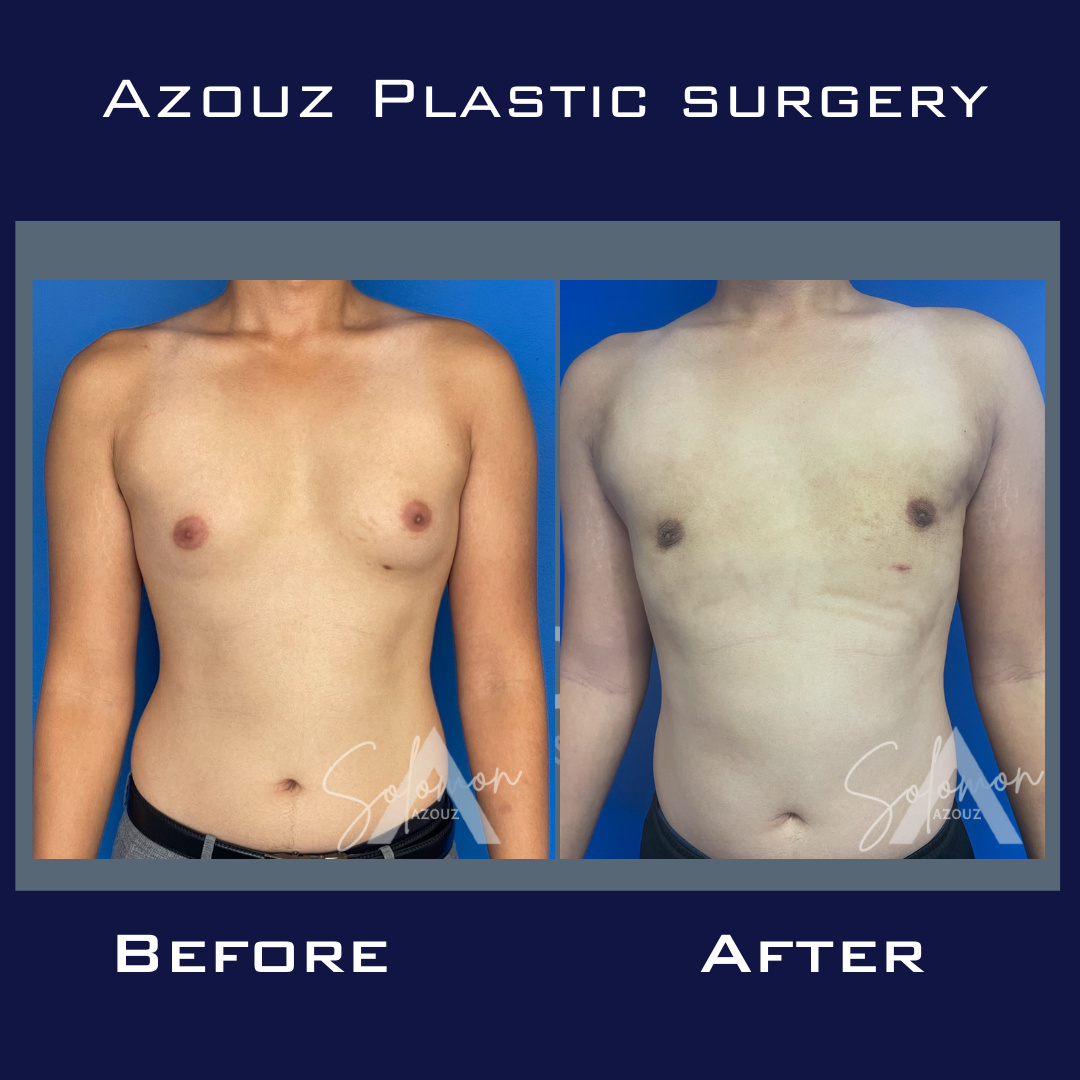

Patients should refrain from heavy activity for a few weeks to allow the body to heal. During follow-up appointments, Dr. Azouz will monitor progress to ensure the best results and a seamless recovery.
Most patients can return to work and routine daily activities within a few days, though excessive exercise and heavy lifting should be avoided until cleared by Dr. Azouz. As the swelling goes down and the chest contour becomes more defined over time, the surgical results will become more apparent.
Combining Gynecomastia and other plastic surgery for men in Dallas
More than ever, men are taking care of the look of their bodies and achieving a more sculpted body. Some patients are interested in knowing more about other plastic surgery procedures for men they can get done while having gynecomastia surgery in Dallas. The most popular procedures combined with gynecomastia surgery are abdominal liposuction, tummy tuck, facelift, and rhinoplasty. Dr. Azouz will address plastic surgery options for men at your consultation and plan a tailored treatment to achieve his patient’s aesthetic goals.
Combining surgeries can save expenses and shorten recovery time by addressing various goals in a single surgical session. During your consultation, Dallas plastic surgeon Dr. Azouz will explore these alternatives with you and assist you in deciding on the most appropriate treatment strategy to fit your specific needs and goals.
What are the different types of lipo that can be used for gynecomastia surgery?
Every liposuction technique has its own advantages and is based on a number of variables, including the patient’s particular anatomy, their desired cosmetic outcome, and the surgeon’s level of experience. Liposuction techniques are selected strategically based on the individual goals and characteristics of each cosmetic procedure including Daddy Do-Over (liposuction of the chest combined with liposuction of the abdomen), male body contouring, and gynecomastia surgery.
Custom cannula liposuction is an advanced technique that tailors the cannula, the suction tube used in liposuction, to each patient’s specific anatomical characteristics. This tailored approach enables accurate and targeted fat removal, maximizing cosmetic results depending on individual requirements.
What kinds of liposuction techniques does Dr. Azouz perform with gynecomastia surgery?
Power-assisted liposuction (PAL) automates the fat removal procedure. The cannula used in PAL is motorized, allowing the surgeon to remove fat with greater precision and efficiency. This approach is especially beneficial in locations where fat deposits are dense or difficult to remove such as stubborn fat.
Ultrasonic liposuction uses ultrasonic energy to liquefy fat cells before suction. This approach aids in the smoother elimination of fat, especially in areas with substantial fat deposits. Ultrasonic liposuction can offer greater precision and effectiveness in contouring targeted regions by breaking down fat into a liquid.
4-D liposuction is intended to provide a more contoured and defined appearance by focusing on certain muscle groups. This method selectively removes subdermal fat to highlight muscular characteristics, resulting in a more athletic and toned appearance.
Three steps make up the entire liposuction strategy known as the SAFE (Separation, Aspiration, Fat Equalization) liposuction technique. It achieves smoother results by separating fat layers, aspirating the targeted fat, and then equalizing the residual fat. During the liposuction procedure, this method reduces damage to the surrounding tissues.
Tumescent liposuction includes injecting a solution including epinephrine into the targeted area. Because of this solution, the fat cells can be removed with reduced bleeding and postoperative discomfort.
Gynecomastia surgery cost
The cost of gynecomastia surgery depends on the patient’s circumstances. There are different factors, such as practice location, surgeon’s fee, anesthesia, surgical facility, lab tests, the extent of the surgery, and post-operative recovery expenses, that are considered to establish a gynecomastia surgery cost. At the initial consultation, Dr. Azouz will evaluate the patient and provide further information about what a patient needs to know before having gynecomastia surgery in Dallas, so the patient can make an informed decision. Dr. Azouz also offers financing options for gyno surgery in Dallas.
Benefits of Gynecomastia Surgery in Dallas
- Remove unwanted fat tissue and achieve an attractive chest.
- Feel confident with your body
- Make physical activity easier.
- Improve posture and reduce back pain.
- Dr. Azouz is an internationally recognized top-rated surgeon in Dallas who is highly experienced performing Gynecomastia surgery
Many individuals who are bothered by the appearance of their chest can benefit from gynecomastia surgery in a variety of ways. The main result is improved self-esteem and a more masculine chest contour. This can dramatically boost confidence, body image, and overall quality of life. Gyno surgery, which removes extra breast tissue and reshapes the chest, often allows patients to feel more comfortable in their own skin and expand their clothing options. Furthermore, gynecomastia surgery is known for producing long-term outcomes, allowing patients to enjoy a better chest contour for years to come. The advantages can go beyond physical improvements, favorably boosting psychological well-being and self-image.
Gynecomastia surgery results
- Male breast reduction commonly occurs in a single surgery
- Flatter and sculpted chest
- Minimal scars
Is gynecomastia surgery worth it?
Undergoing gynecomastia surgery with Dr. Azouz ensures ideal natural and quick results, improving not just an individual’s physical look but also their general confidence. Dr. Azouz, a gynecomastia expert, uses innovative methods to create a more sculpted and masculine chest. Following surgery, many patients report feeling more at ease wearing tighter shirts. It is a popular option for anyone looking for a positive and long-lasting transformation, which is not only attractive but also substantially increases one’s self-confidence. It is best to discuss your specific goals with top-rated plastic surgeon Dr. Azouz to explore options for gynecomastia.
What patients are saying
Schedule a consultation with Dr. Azouz
If you are considering surgery for your gynecomastia and wish to find a solution to excess chest fat and tissue that are resistant to diet and exercise, male breast reduction surgery may be the right choice for you. Take the first step and call (972) 702-8888 to schedule your in-person consultation with Dr. Azouz in Dallas or contact Azouz Plastic and Cosmetic Surgery to schedule your virtual consultation for out-of-town patients.
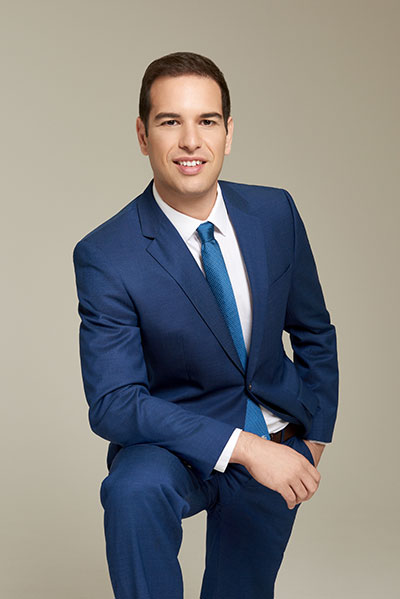
Frequently Asked Questions
Men can develop breasts. This condition is known as gynecomastia.
True gynecomastia, which is the result of excess breast tissue, requires surgery. However, some patients may experience the appearance of gynecomastia due to excess fat alone, which can be resolved through weight loss.
In many cases, gynecomastia is only resolved through surgery. This is because the condition is caused by excess breast tissue which must be surgically removed.
It is possible to reduce breast size by losing weight. However, the appearance of male breasts is likely to persist due to excess breast tissue.
Gynecomastia is unlikely to reoccur after surgery. Maintaining a healthy, stable weight and addressing any underlying causes of gynecomastia will help you maintain your results.
Some weight loss may occur after a breast reduction due to the weight of the removed tissue. Weight loss is not the primary goal of male breast reduction.
Thyroid problems are a common cause of gynecomastia. Patients with these issues should seek treatment from their doctor in addition to a plastic surgeon.
A breast reduction can make you appear thinner or more physically fit.
Gynecomastia is caused by excess breast tissue and is often the result of a hormonal imbalance. Pseudogynecomastia is caused by excess fat in the chest area.
- Improved male chest contours
- Reduced breast size for overdeveloped breasts
- Reduced excess fat in male breasts
- Reduced excess glandular tissue in male breasts
- Improved confidence and self-esteem
Dr. Azouz has helped many men improve the appearance of their chest. His gynecomastia reduction surgery can help form a more muscular and attractive look. After male breast reduction surgery, men may notice a significant increase in their self-esteem and find their gynecomastia surgery to be life-changing. They can become more comfortable taking off their shirt while swimming, going to the beach, or in front of their partners.
Poland’s Syndrome is a condition in which an individual is born with undeveloped or missing muscles on one side of the body. These underdeveloped areas can occur in the chest, arm, and hand. Dr. Azouz also helps men with Poland’s Syndrome or a congenital absence of the chest muscle. He uses similar techniques as in gynecomastia surgery to give patients with Poland Syndrome a more natural, constructed chest contour.
Gynecomastia surgery results are considered to be permanent unless you gain a considerable amount of weight post-surgery. You should also avoid the use of anabolic steroids to get the most long-term results out of your procedure.
This procedure will leave scars at the incision sites just like any other surgical procedure. Dr. Azouz camouflages scars so that they are difficult to see. Scars heal over time with proper care and sun protection. In approximately a year, the scars should fade dramatically. Dr. Azouz routinely performs gynecomastia surgery through the hidden/camouflaged incisions and places only one incision hidden below the areola on each breast.
A gynecomastia procedure is typically performed on an outpatient basis and will most likely require a few days of rest. Depending on the nature of your job, you may need to take more or less time off. For more specific answers to this question, be sure to discuss this at length with Dr. Azouz during your consultation.
After male breast reduction surgery, you can expect to see a reduction in the amount of breast tissue immediately. You will most likely experience some tenderness and swelling for the first few weeks, but this should subside within 2-4 weeks. Dr. Azouz recommends browsing his Before and After Gallery to see what gynecomastia treatment results you can expect.
Since gynecomastia surgery is performed under local anesthesia with sedation, pain is not felt during the procedure.
Yes. The goal of gynecomastia surgery is to even out and reduce the size of male breasts. The result is a flatter, more masculine look. With less breast tissue, muscle definition will appear more defined and prominent.
Like any procedure in which excess fat and tissue are removed, there is always a risk for the results to be affected by weight gain. If a patient gains weight after a Gynecomastia surgery, the stress of new excess fat can cause it to collect in specific areas.
Luckily, major risks with gynecomastia surgery are quite rare. The procedure is straightforward and only involves the removal of fatty tissue. However, all surgery carries some degree of risk. Some of the more common risks associated with surgery are allergic reactions, hematoma/seroma, or damage to surrounding structures.
Gynecomastia Surgeon, Dr. Azouz, will provide you with complete instructions for the preparation before your procedure. He will also give you an opportunity to ask any questions that you may have about the procedure. In general, it is important to take good care of yourself before surgery such as stop smoking, hydrate, and avoid over sun exposure within four weeks before your procedure.
The exact cost of a gynecomastia procedure can only be determined after a consultation with Dr. Azouz. If you would like more specific details regarding all the fees involved in a cosmetic surgery procedure, contact the office of Dr. Azouz today and his helpful office staff will be able to assist you.
Surgery is the gold standard of treatment. Liposuction and removal of the retroareolar breast tissue has been an extremely effective method to recountour and enhance the male chest. This day surgery has been beneficial to countless numbers of men afflicted with gynecomastia in our practice in Dallas. Patients have flown in from all over the world including Canada, Mexico, Europe, India, Dubai, Saudi Arabia, Argentina and Central America to have the procedure done in Dallas. Patients often undergo sedation and are not put under a full general anesthetic. This minimizes the risk of anesthesia while allowing the patient a twilight anesthesia where they are asleep without the need for intubation. In the majority of cases, gynecomastia is caused by genetics and not caused by the actions on the patient.
Smoking inhibits the microvascular blood supply and affects the healing of tissues. It is not recommended to use tobacco and nicotine products at any time before and after surgery as it will interfere with normal wound healing. There are many patients who are smokers and still have optimal results despite their habits.
A tummy tuck and gynecomastia surgery can often be performed simultaneously. Liposuction of the abdomen can also be performed at the same time as gynecomastia surgery. This allows for one anesthetic and simultaneous healing.
Dr. Azouz offers many inexpensive yet effective options for compression garments after gynecomastia surgery. Dr. Azouz recommends garments that are snug but not too tight as patients will routinely be placed into compression garments at the end of surgery.
Dr. Azouz sees many patients who gave gone to other surgeons and are in need of revision gynecomastia surgery. Dr. David Azouz has been performing gynecomastia surgery for many years and has performed many thousands of cases. These include revising gynecomastia surgeries that have been performed in the United States and in many countries throughout the world. Dr. Azouz has been able to improve contour irregularities, puffy nipples, asymmetries, and remove residual gynecomastia through small hidden/camouflage incisions in many cases of revision male breast reduction.
The duration of gynecomastia surgery depends on several factors like a patient’s individual anatomy if the patient has had surgery previously if scar revision is required and is dependent on how much gynecomastia, scarring, and fatty tissue is present in the chest. Dr. Azouz generally recommends that a male breast reduction surgery takes around an hour to less than an hour in most men depending on their medical history and chest anatomy.
Dr. Azouz uses a variety of excision and liposuction techniques to perform gynecomastia surgery. Dr. Azouz uses tumescent liposuction, high definition liposuction, safe liposuction and high definition liposuction techniques in combination to afford his patients a sculpted and aesthetic (cosmetic) masculine chest. Dr. Azouz is routinely able to camouflage his incisions to afford patients a natural result without visible scarring. Many patients have reported being unable to see incisions or scars after surgery.
Dr. Azouz does not remove the pectoralis muscle with his technique. Some patients have a condition called Poland Syndrome (lack of the pectoralis muscle) which requires placement of an implant (pec implant) to recreate the appearance of a pectoralis muscle.
As with any surgery, there are risks, including infection, scarring, and changes in sensation. Board-certified plastic surgeon Dr. Azouz will discuss potential complications during the consultation and provide information on minimizing risks.
In most cases, gynecomastia surgery is considered a cosmetic procedure and is not covered by insurance. However, individual policies vary, so it's advisable to check with your insurance provider.
While the removed glandular tissue will not return, maintaining a healthy lifestyle is crucial to preventing the accumulation of excess fat in the chest area.

